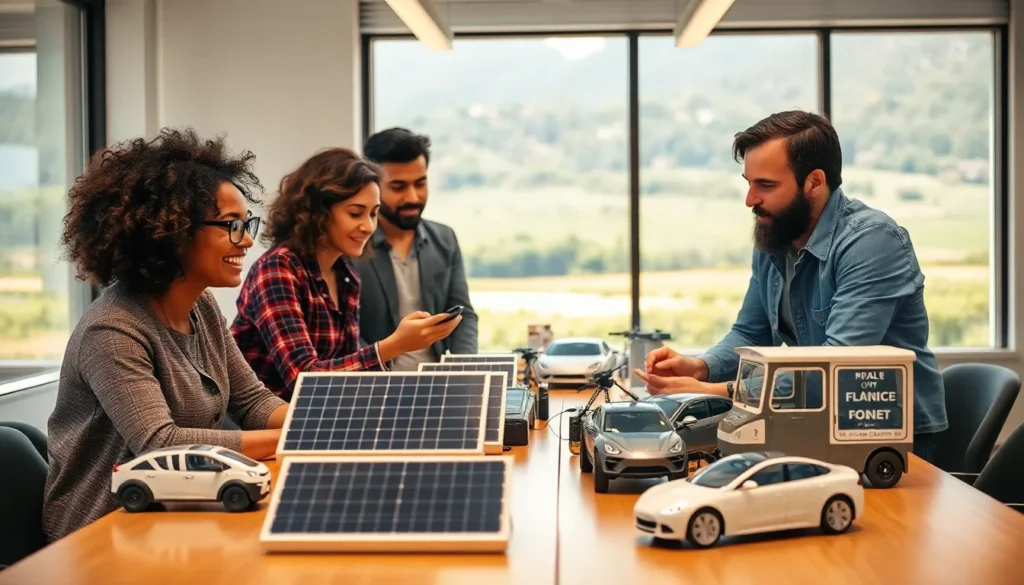Table of Contents
ToggleIn a world where technology often gets a bad rap for its environmental impact, sustainable tech initiatives are stepping in like superheroes in capes made of recycled materials. These innovative solutions are not just saving the planet; they’re making it cooler while doing so. Imagine a future where your smartphone not only connects you with friends but also helps reduce carbon footprints. Sounds like science fiction? Think again!
Overview of Sustainable Tech Initiatives
Sustainable tech initiatives focus on reducing environmental impacts through innovative practices. Companies invest in renewable energy sources, such as solar and wind power, to minimize dependency on fossil fuels. Electric vehicles, equipped with advanced battery technology, produce fewer emissions compared to traditional vehicles.
Many organizations adopt circular economy principles, ensuring that products are designed for reuse and recycling. This approach significantly reduces waste while promoting resource efficiency. Smart technologies, including IoT devices, optimize energy consumption in homes and businesses, leading to substantial cost savings.
Data centers now utilize energy-efficient cooling systems and renewable energy, drastically cutting their carbon footprints. The adoption of green software, which emphasizes efficiency in coding practices, contributes to lower energy use during operation. Smart grids enhance energy distribution, storing surplus energy for later use and reducing reliance on non-renewable sources.
Sustainable practices promote social equity by allowing access to technology for underserved communities. Organizations also encourage transparency in corporate social responsibility, showcasing their commitment to sustainability. Reduced plastic usage in product packaging illustrates a broader trend toward environmental stewardship.
Research and development drive innovation within sustainable tech, leading to breakthroughs in clean technology. Investment in technologies like carbon capture helps mitigate impacts on the environment. Education around climate change and sustainability continues to raise awareness and promote collective action.
Emerging trends, such as biodegradable materials and energy-efficient appliances, reflect a commitment to a sustainable future. These initiatives offer practical solutions to pressing environmental issues, fostering a transformative approach towards technology’s role in society.
Key Areas of Focus

Sustainable tech initiatives play a pivotal role in advancing environmental responsibility. Several key areas contribute to this shift toward a more sustainable future.
Renewable Energy Solutions
Renewable energy solutions have gained significant momentum recently. Companies are increasingly investing in solar and wind power to harness clean energy. Many organizations now prioritize energy efficiency in their operations. Significant reductions in greenhouse gas emissions occur when businesses transition to renewable energy sources. In 2021, solar energy accounted for approximately 11% of the total electricity generated in the U.S. This figure reflects the growing acceptance and implementation of renewable technology, illustrating a commitment to sustainability.
Waste Management Technologies
Innovations in waste management technologies help minimize environmental impacts. Advanced recycling systems and waste-to-energy facilities improve resource recovery. Many municipalities adopt smart waste bins equipped with sensors that notify collection services when full. The integration of AI-driven sorting systems enhances recycling efficiency by reducing contamination rates. In 2020, the global waste management market reached $2 trillion, emphasizing the demand for sustainable waste solutions. Investing in these technologies leads to reduced landfill use and promotes a circular economy.
Sustainable Agriculture Practices
Sustainable agriculture practices are transforming food production systems. Farmers increasingly utilize precision agriculture technologies to optimize resource use. Techniques such as drip irrigation and soil monitoring contribute to water conservation and improved yields. Organic farming practices, which eliminate synthetic chemicals, are also on the rise. In the U.S., organic farmland increased by 56% between 2011 and 2021, highlighting this trend. Initiatives focused on agroecology encourage biodiversity and promote healthier ecosystems while ensuring food security.
Case Studies
Sustainable technology initiatives demonstrate a range of approaches toward environmental enhancement. These examples spotlight practical implementations and lessons derived from challenges faced.
Successful Implementation Examples
IKEA invested heavily in solar energy, achieving a 100% renewable energy commitment for its global operations. The company has installed solar panels on store rooftops, generating energy while reducing reliance on fossil fuels. Microsoft’s AI for Earth program focuses on climate change, leveraging artificial intelligence to address environmental challenges. This initiative empowers organizations to analyze and predict ecological impacts effectively. Additionally, Tesla’s solar roof products offer sustainable energy solutions that seamlessly integrate with homes, promoting a greener lifestyle.
Lessons Learned from Failures
Several companies faced setbacks while pursuing sustainable technology. For instance, early solar initiatives suffered from high costs and limited efficiency, discouraging investment. Organizations must prioritize scalability in their solutions to foster greater adoption. Furthermore, attempts at recycling e-waste without proper facilities led to environmental contamination in some regions. Learning from these failures emphasizes the importance of robust infrastructure. Each setback clarifies the need for technological advancements paired with responsible waste management practices.
Challenges and Barriers
Sustainable tech initiatives face several challenges and barriers that hinder their widespread adoption. Two significant obstacles include financial constraints and regulatory hurdles.
Financial Constraints
High initial costs create barriers for companies looking to implement sustainable technologies. Many organizations struggle to allocate budgets for innovative solutions due to tight margins. Lack of funding restricts research and development opportunities, reducing advancements in green technologies. Investors often prioritize short-term returns, leading to hesitancy in funding long-term sustainable projects. Cost-benefit analyses can underestimate the long-term savings associated with these technologies, further discouraging investment. Companies seeking financing may also encounter challenges in accessing capital, especially small businesses aiming to go green.
Regulatory Hurdles
Complex regulations impede sustainable tech growth across various industries. Conflicting laws at local, state, and federal levels create confusion for organizations trying to comply with sustainability standards. Additionally, regulatory frameworks can lag behind technological advancements, hindering innovation. Companies may find themselves facing lengthy approval processes for new sustainable products, delaying market entry. Furthermore, inconsistent policies can create uncertainty, discouraging investment in sustainable initiatives. Companies operating across borders must navigate different regulations, complicating global sustainability efforts.
Future Trends
Emerging technologies drive sustainability towards significant advancements. Enhanced efficiency in renewable energy domains, particularly solar and wind power, shows promise for reduced greenhouse gas emissions. Companies prioritize energy-efficient solutions, leading to innovative strides in electric vehicle technology and battery efficiency.
Smart technology adoption continues to rise, allowing for better energy management in buildings and industries. IoT devices streamline energy consumption, ultimately resulting in lower costs and reduced waste. The integration of smart grids further enhances energy distribution, minimizing reliance on non-renewable sources.
In the realm of waste management, advanced recycling systems gain traction as they improve resource recovery rates. AI-driven sorting technologies increase efficiency in the recycling process, emphasizing the importance of a circular economy. Such developments align with sustainable agriculture practices, which involve precision farming techniques enhancing resource use and supporting global food security.
With a focus on clean technology research, innovative materials emerge. Biodegradable alternatives to conventional plastics represent a critical shift in reducing environmental impact. Energy-efficient appliances showcase the industry’s commitment to sustainable living, shifting consumer habits towards eco-friendlier choices.
Significantly, social equity remains a core component of future sustainability efforts. Increasing access to technology for underrepresented communities fosters inclusivity and promotes transparency in corporate social responsibility initiatives. As momentum builds around these trends, stakeholders in sustainability recognize that the collaboration among various sectors accelerates progress, shaping a greener, more sustainable future for technology.
Sustainable tech initiatives are reshaping the landscape of environmental responsibility. By integrating innovative practices and technologies, companies are not only reducing their carbon footprints but also paving the way for a more sustainable future. The focus on renewable energy, waste management, and social equity highlights the multifaceted benefits of these initiatives.
As advancements continue in areas like smart technologies and biodegradable materials, the potential for significant positive impact grows. Collaboration across sectors will be crucial in overcoming barriers and fostering widespread adoption. With a collective commitment to sustainability, the tech industry can play a vital role in addressing pressing environmental challenges and promoting a healthier planet for all.




